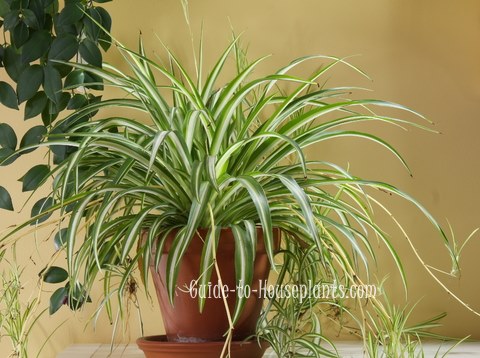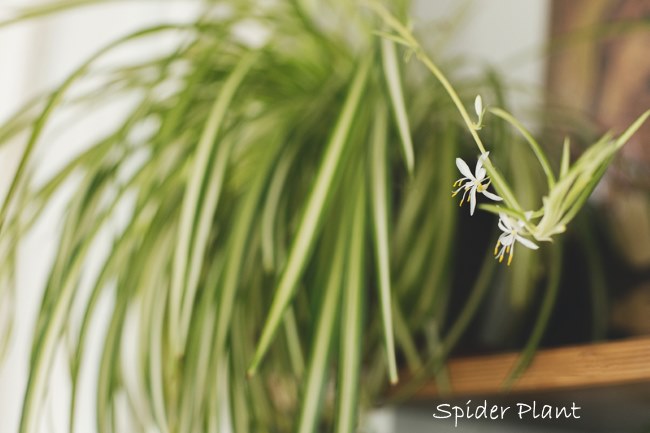How to Grow Spider Plant
Chlorophytum comosum, commonly known as spider plant, is an impressive house plant for beginners. It's easy to care for, tolerates average room conditions, and is easy to propagate.
Spider plants look best in hanging baskets or on tall stands or pedestals to show off their trailing foliage. Their variegated leaves and graceful, fountain-like growing habit add a beautiful contrast and texture when grouped with other house plants.

Get to Know Spider Plant
The slender, arching leaves are dark green with a creamy white stripe. Leaves grow from a central crown and can reach up to 1 ft (30 cm) long. Give this plant plenty of light for the best leaf color. Plants grown in low light may lose their variegation.
When less than a year old, the plant produces small, white flowers on the tips of wiry, upright stems, called runners. The runners are soon weighted down with plantlets giving it a spidery appearance.
These plantlets -- often called "babies" -- are easy to propagate, giving you an ongoing supply of plants. For sure success, choose young, small plantlets when they begin to develop roots for propagating because older plantlets will root slowly. (See "Propagation" below for all the how-tos.)
 Spider plant readily grows plantlets that are easy to propagate. Photo © Bogdan Sonyachny
Spider plant readily grows plantlets that are easy to propagate. Photo © Bogdan SonyachnySpider Plant Problems, Solutions and Special Helps
Repot in spring when the plant has outgrown its pot. If you see roots growing out of the drainage holes, it's time to pot up. For the best growth and flowering, use a pot that's only 1 to 2 inches larger than the old one. Remember to always use a pot with drainage holes to prevent soggy soil, which can lead to root rot.
No blooms? Spider plants like to be slightly root-bound and will flower and produce plantlets best when grown in a smallish container. Also, take it easy on the fertilizer -- too much will produce a lot of leaves, but no flowers and plantlets.
Brown leaf tips seen on this plant may be a symptom of hot, dry air or dry soil. Or may be caused by fluoride, often present in tap water. Use distilled water, rainwater, or allow tap water to sit overnight so that the chemicals in the water will dissipate. Snip off brown leaf tips with scissors, if you want, to keep the plant looking neat.
Something bugging your plant? Watch for scale insects. These tiny pests look like brown discs that attach themselves to the leaves and stems. They can be scraped off the leaves. Isolate an infested houseplant to prevent them from moving on to your other indoor plants.
Buy a Spider Plant
This is one of the best plants for improving air quality indoors. It has one of the top removal rates of formaldehyde from tainted indoor air.
You'll find a couple types available. 'Vittatum' is the most common variety, featuring a central white stripe on its foliage. 'Variegatum' has broader green leaves with reverse variegation: a green central stripe with white margins. 'Bonnie' sports curly leaves.
Spider Plant Care Tips
Origin: South Pacific and South Africa
Height: Plants grow up to 1 ft (30 cm) tall, with stems trailing to 3 ft (90 cm) in length.
Light: Give your spider plant bright, indirect light to maintain the variegation on the leaves. Keep plant out of direct sunlight because it can scorch the foliage, leaving dry, brown patches.
Water: Keep soil lightly moist in spring and summer, when spider plant is actively growing. In fall and winter, allow the top 1-inch (2.5 cm) to dry before watering again. If your tap water contains fluoride, use distilled or rainwater to prevent brown leaf tips on your plant.
Humidity: Aim to maintain 45% indoor humidity year-round. If the leaves turn brown and crispy, raise the humidity around it. This is easy to do. Set the planter on a humidity tray or use a cool-mist room humidifier near the plant.
Temperature: Average room temps 65-75°F/18-24°C suit this tropical plant perfectly. It doesn't like the cold; don't expose it to anything below 50°F/10°C.
Soil: Peat-moss based potting mix, with added perlite and vermiculite for good drainage, such as African violet mix.
Fertilizer: Feed every 2 weeks spring through summer with a water-soluble fertilizer diluted by half. Don't feed in the fall and winter months, when growth is slow.
Propagation: Plantlets. Set a small pot filled with damp potting mix next to the plant. Sink a new plantlet into the soil of the small pot, so that the root buds are barely covered. You may need to use a bent paperclip to hold the plantlet in place. It should root in 2-3 weeks. After that time, sever it from the parent plant. Spring is the best time for propagation, when spider plant is beginning its most vigorous time of growth.


